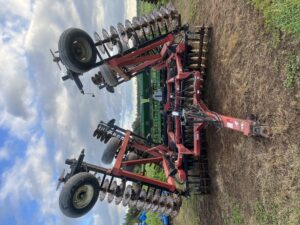Vertical Tillage
go.ncsu.edu/readext?941329
en Español / em Português
El inglés es el idioma de control de esta página. En la medida en que haya algún conflicto entre la traducción al inglés y la traducción, el inglés prevalece.
Al hacer clic en el enlace de traducción se activa un servicio de traducción gratuito para convertir la página al español. Al igual que con cualquier traducción por Internet, la conversión no es sensible al contexto y puede que no traduzca el texto en su significado original. NC State Extension no garantiza la exactitud del texto traducido. Por favor, tenga en cuenta que algunas aplicaciones y/o servicios pueden no funcionar como se espera cuando se traducen.
Português
Inglês é o idioma de controle desta página. Na medida que haja algum conflito entre o texto original em Inglês e a tradução, o Inglês prevalece.
Ao clicar no link de tradução, um serviço gratuito de tradução será ativado para converter a página para o Português. Como em qualquer tradução pela internet, a conversão não é sensivel ao contexto e pode não ocorrer a tradução para o significado orginal. O serviço de Extensão da Carolina do Norte (NC State Extension) não garante a exatidão do texto traduzido. Por favor, observe que algumas funções ou serviços podem não funcionar como esperado após a tradução.
English
English is the controlling language of this page. To the extent there is any conflict between the English text and the translation, English controls.
Clicking on the translation link activates a free translation service to convert the page to Spanish. As with any Internet translation, the conversion is not context-sensitive and may not translate the text to its original meaning. NC State Extension does not guarantee the accuracy of the translated text. Please note that some applications and/or services may not function as expected when translated.
Collapse ▲Vertical tillage management is a minimal tillage practice conducted to work on the vertical profile of the soil. This tillage practice is designed to help in residue management while mixing soil enough to form a seedbed that can facilitate organic matter formation/residue decomposition. There are multiple definitions and considerations in the market regarding vertical tillage management. Therefore, it is essential to understand what it means and familiarize yourself with various equipment in this category to decide whether this tillage management suits a particular field and your requirements.
Utilization of vertical tillage equipment ensures that soil is disturbed to shallow/deep depths vertically, however, with no soil movement horizontally (side to side). A true vertical tillage equipment would have straight blades with no angle, and any equipment with concave blades cannot be included in this category. The extent of soil disturbance and crop residue burial can vary; however, in any case, vertical tillage does not involve sweeping the soil (shearing) horizontally.
Vertical tillage prevents density changes between the tilled layer (looser) and subsurface layers (firmer) which happens with horizontal shearing. This helps tackle the possible hardpan formation and a subsequent interruption to normal root growth. They also help to size the residue, leaving a smooth seedbed for seed placement. Avoiding abrupt changes in density allows for improved water infiltration, enhanced root development, efficient nutrient uptake, and better yields. However, they are not effective in complete weed control, and the efficacy would depend on the soil conditions- they can tackle shallow-rooted weeds in wet loose soils but not deep-rooted weeds in dry, firm soils. Some primary and secondary tillage equipment that fall in vertical tillage management are mentioned below:
Primary tillage tools that can be used for vertical tillage:
Subsoiler: A vertical tillage equipment that is used to alleviate soil compaction and reset vertical soil profile up to 12-18 inches while burying minimal soil residues. The shape and angle of the shank attached (straight, parabolic, bent leg) determine the extent of soil disturbance. Fifty horsepower can be required per shank for efficient operation.
Disk chisel: This equipment can be used by growers who require more surface residue burial (50-75%). The coulter blades are not straight and hence cannot be considered as a true vertical tillage equipment; however, the chisel shanks running below the discs help remove the density layer produced and facilitate vertical tillage.
Chisel plow with vertical points: This is considered vertical tillage when used with vertical points, as they don’t cause shearing or density changes in the soil. Can bury 50 to 60% of crop residue.
Secondary tillage tools used for vertical tillage:
Spike tooth harrow: A vertical tillage equipment used as a secondary tillage leveling tool, requiring much less horsepower (5-6 hp/foot). It helps with sizing residues, breaking clods, and leaving a smooth bottom seedbed at planting depth suited for seed placement.
The type of vertical tillage practice can be decided based on the existing field conditions and current tillage practices. For example, conducting shallow vertical tillage in fields with existing hardpan layer below tilled soil can lead to cut residues on the surface being washed away with rain. This happens when the rainwater cannot infiltrate the already existing hardpan on the field. In such cases, deep vertical tillage with subsoilers can be recommended. Management of the thick, tough stalk residues is essential in corn production systems, rotated with corn or soybean. A conventional tillage practice like moldboard plow can manage the stalks; however, it can bury them so deep in soil that they are not exposed to oxygen required for decomposition, leading to a decline in organic matter over the years. Whereas a vertical tillage practice can ensure the maintenance of residues on the surface, and, at the same time, help create a uniform soil profile with multiple agronomic, economic, and environmental benefits. In order to properly apply this approach, join our extension and education activities.



